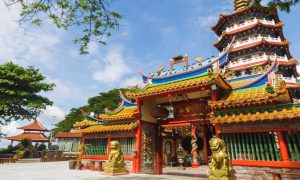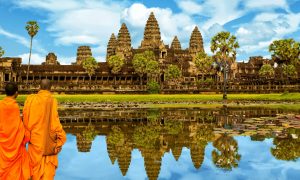With its proximity to Malaysia and so many varied destinations within it, Vietnam is a place Expats should not overlook. Sarah Rees urges holidaymakers to invest some time in exploring Vietnam, the second country in our Asean series.
There are many tempting locations within a short hop from Malaysia, but one that too often gets overlooked is Vietnam. Once the trendy place to go for the intrepid backpacker, Vietnam’s appeal is getting forgotten as the tourist tides turn; Laos and Myanmar are becoming the top options for the backpackers seeking “undiscovered” terrains, while those in the mood for sun and sea head to the ever-luscious Bali.
And yet Vietnam can more than compete on both accounts, boasting a coast that stretches the length of the country and enough stuck-in-time places to make any culture-hungry foreigner reach for the camera and begin to grin. Ancient temples, stretches of beach, history, highland cool, food at whatever your price, and markets that will overwhelm with variety; Vietnam has so much to offer in a country packed with cities and towns that charm in their individuality and yet all pulsate the warmhearted spirit of the Vietnamese.
Hanoi
For the old Asia of your imagination, make Hanoi your number one destination and book a hotel down one of the narrow alleys of the Old Quarter, where noodles are cooked on the side of the road, tiny old woman carry wooden baskets packed high with wares, barbers set up their chairs on the side of busy roads, and the motorbikes race and weave like ants on acid.
The serene Hoan Kiem Lake is the centre of activity, and while hours can be frittered away enjoying the markets, curious edibles, and exploring the old shophouses, more concrete facts can be soaked up at the museums. Visitors with an open mind can even doff their hats to Ho Chi Minh himself at the mausoleum. Parks, temples, and food galore ensure there is plenty to keep the whole family amused, while many people tack on a three-day excursion to the beautiful Ha Long Bay, where a junk cruise will take you along the bluest, clearest waters you may ever see.
Hue
This sleepy, charming place on the Perfume River is known for the Imperial City that was the headquarters of the royal family from 1802-1945. The large, quiet complex is remarkably intact, and offers an insightful experience for those seeking more from Vietnam than the recent, messy history. Life is laid-back in Hue – cycling along the lanes or taking a river cruise are both popular options – and the only other major tourist attraction are the various, spectacular, Tombs of the Emperors.
Da Nang
As Central Vietnam’s largest city, Da Nang is often the embarkation point for those exploring the nearby destinations of Hue and Hoi An, or with a mind to head straight to one of the many beach resorts to laze under a cloudless sky.
Some see little to interest them in the city itself, but with a number of museums, many bars and restaurants, and a long stretch of river- and sea-front areas promising some spectacular sunsets, Da Nang shouldn’t be overlooked.
Hoi An
This UNESCO World Heritage Site deserves all the praise it gets. A day spent in this gorgeously preserved – if a little commercial – place is a real insight into the Vietnam of old, when Hoi An was a major shipping port for the spice trade.
Chinese shophouses, temples, ornate bridges, and riverfront restaurants lull the visitor into a state of relaxed appreciation, while souvenirs of every imaginable size, shape, and colour are available to take back as a keepsake. Many foreign tourists make a beeline for the tailors, who are country-renowned for the low prices and speed of creation, producing customers’ clothes as they see the sights.
Nha Trang
Proof that Vietnam can pull its weight when it comes to beach brilliance is Nha Trang, a town that sits along a gleaming coast and was a spot once loved by the American GIs, who frequented the city for a spot of R&R.
There are plenty of resorts, hotels, restaurants, and cafes to satisfy whatever the budget, and those who can’t resist the lure of the water will be pleased to hear that this is the scuba diving capital of the country. Many centres offer courses, day trips, and even beginner-level “experience” outings for those who are nervous and/or clueless.
Da Lat
Think Vietnam is just heat and beach? Let Da Lat, a former French hill station, prove that assumption incorrect with its eternal spring-like temperatures and gorgeous rolling green hills that fall away below the winding highland roads.
The indigenous tribes who call the area home add a fascinating element to the climatic pleasure of this little town, and the range of architectural influences reward any with an eye for design and the patience to walk the streets.
Ho Chi Minh City
While Hanoi may be the “old” heart of the country, Ho Chi Minh City (formerly Saigon) is pushing into the new, with malls, hotels, and traffic buzzing around.
That said, there is still much for the historical tourist to discover, and Vietnam’s history can be walked through at the grisly War Remnants Museum and Reunification Palace.
More sedate culture can be enjoyed in one of the many parks, in the maze-like markets, or at the cathedral, while lots of bars, restaurants, cafes, clubs, hostels, and hotels cater to any budget.
———————————————————————————————————
Vietnam
Size: 331,210 km2 (World rank: 65th)
Population: 90.4 million (2012)
Capital city: Hanoi
Largest city: Ho Chi Minh City (Saigon)
Government: Unitary socialist single-party state
Official language: Vietnamese
GDP PPP*: $3,545
HDI**: 0.593, medium (World rank: 128th)
Currency: Vietnamese dong (1MYR = 6,765VND); about 20,000VND per USD
*GDP per capita, purchasing power parity, international dollars **Human Development Index, a comparative measure of life expectancy, literacy, education, standards of living, and quality of life for 187 countries worldwide.
Notable facts:
The stunning Ha Long Bay, in Quang Ninh province near the northern border of Vietnam, is a UNESCO World Heritage Site. The site’s name translates as “Descending Dragon Bay.”
The longest cable-stayed bridge in ASEAN is found in Vietnam. C.n Th' Bridge, with a main span of 550m, was opened to traffic in April 2010.
The critically endangered saola, or Vu Quang ox, one of Earth’s rarest mammals, is native to the Annamite Range of Vietnam.
———————————————————————————————————
Finally Free
The Vietnamese may be among some of the sweetest, kind-hearted people you will meet in Asia, but the more recent history of the country is one of war, rebellion, and a struggle for control of this lengthy stretch of lush tropical terrain.
Vietnam has one of the longest continuous histories in the world: archaeological finds date the first signs of life at around half a million years ago and suggest that these early people were some of the first to practice agriculture.
The country enjoyed a prosperous Bronze Age from 1,000BCE to 1BCE, producing many items that found their way all over the region. It is perhaps this that first attracted the eyes of foreigners, and soon the unified country was to face an endless stream of invaders and colonialists, from the long influence of the Chinese to the shorter – and considerably bloodier – involvement of the French and Americans. France’s arrival in 1885 changed the fabric of the country in a very real way, importing Roman Catholicism and modernizing many aspects of the country, as well as establishing a plantation economy and bleeding money from the land through exports of tobacco, indigo, tea, and coffee.
The Japanese had a brief time of occupation during World War II, and once the French arrived to claim it back the Vietnamese had decided enough was enough. Ho Chi Minh and his nationalist liberation movement declared themselves leaders and a war ensued, resulting in the dividing line being establishing to create the Democratic Republic of Vietnam in the North and the State of Vietnam in the South, with Ho Chi Minh taking the state leadership in 1954.
Within a few years, the communist guerillas in Northern Vietnam had grown tired of the rule of Ho Chi Minh and launched an attack on their southern counterpart, which eventually led into what is commonly referred to as the Vietnam War (called the American War in Vietnam). It was, for all involved, a bloody and protracted war spanning two decades which left hundreds of thousands dead and much of the country destroyed.
The Americans withdrew beginning in 1973, and by June 1976, the north and south had come together to form the Socialist Republic of Vietnam that exists to this day, with Hanoi, from that moment on, serving as the capital city.
———————————————————————————————————
Source: The Expat March 2013
Read more:
- What on Earth is Christmas Island?
- Top Sight Seeing Destinations in Kuala Lumpur
-
Five Fabulous Train Journeys in Malaysia
What are your thoughts on this article? Let us know by commenting below.No registration needed.
















